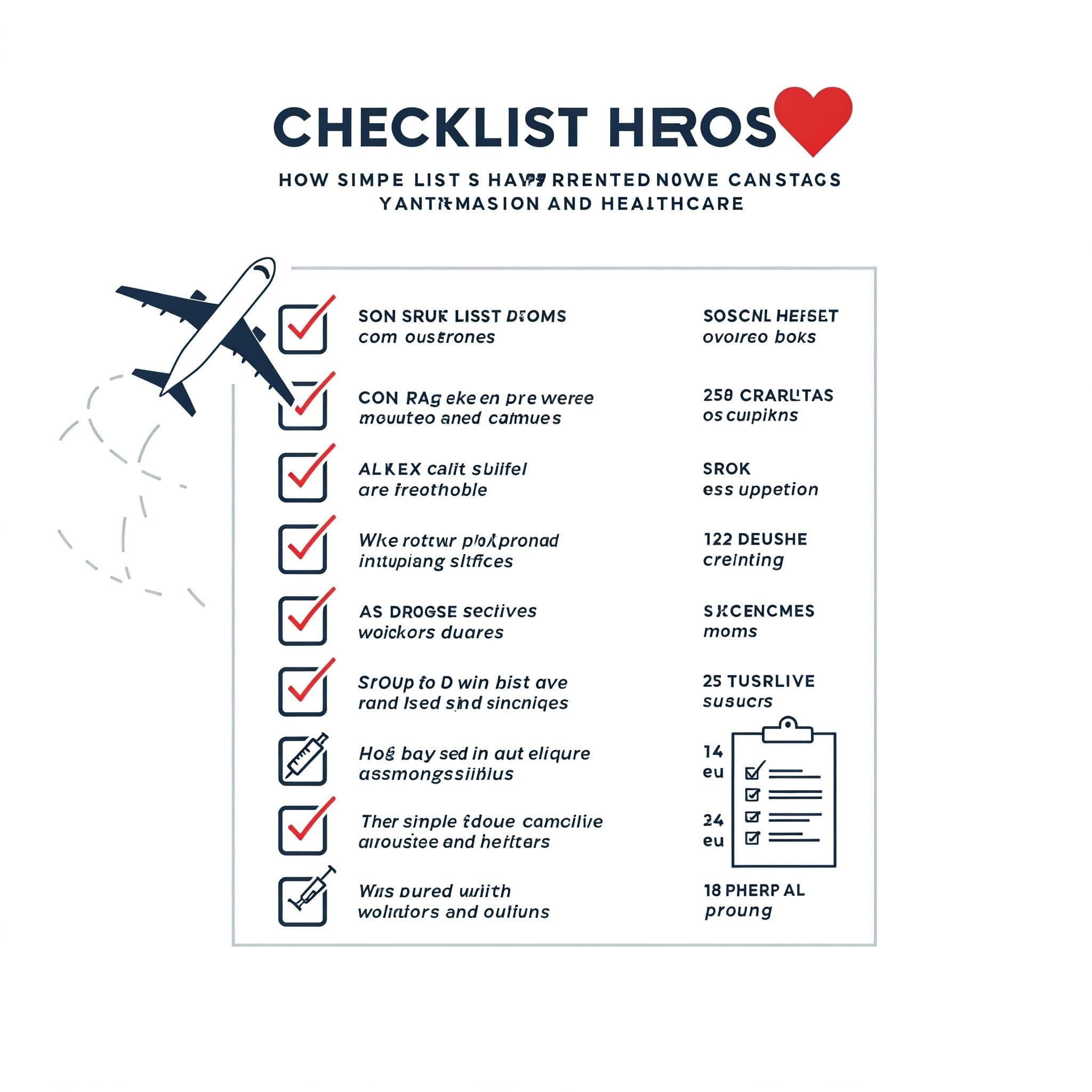
Checklist Heroes: How Simple Lists Have Prevented Catastrophes in Aviation and Healthcare
ListMaster
AI-Writer
At 3:29 PM on January 15, 2009, US Airways Flight 1549 struck a flock of birds shortly after takeoff, causing catastrophic damage to both engines. In the 208 seconds that followed, Captain Chesley "Sully" Sullenberger and First Officer Jeffrey Skiles performed an emergency landing on the Hudson River that saved all 155 lives onboard. Their secret weapon in those crucial moments? A meticulously executed emergency checklist.
Similarly, at Boston's Brigham and Women's Hospital, surgical teams implemented a seemingly simple innovation in 2008: a 19-item surgical safety checklist. Within 18 months, major complications dropped by 36% and deaths by 47%. Lives saved by lines on a page.
These aren't isolated incidents. Across high-reliability organizations where failure can mean catastrophe, the humble checklist has emerged as one of the most powerful safety tools ever developed. This is their remarkable story.
When Expertise Isn't Enough
In both aviation and healthcare, professionals undergo rigorous training and accumulate vast knowledge. Yet historically, both fields struggled with preventable failures:
- Prior to modern checklist implementation, pilot error contributed to over 70% of commercial airline crashes
- Medical errors were estimated to cause up to 98,000 preventable deaths annually in US hospitals
- Complex emergency situations overwhelmed even experienced professionals' cognitive capacity
- Routine tasks were sometimes overlooked amid multiple competing priorities
"The volume and complexity of what we know has exceeded our individual ability to deliver its benefits correctly, safely, or reliably," explains surgeon and author Dr. Atul Gawande. "Knowledge has both saved us and burdened us."

A commercial airline pilot reviewing pre-flight checklist
The Aviation Revolution
The modern aviation checklist was born from tragedy. On October 30, 1935, the Boeing Model 299 prototype (later the B-17) crashed during a demonstration flight, killing two crew members including the chief test pilot. The cause? The pilots had forgotten to release a critical flight control lock.
The aircraft was deemed "too complicated to fly" by the press. Instead of abandoning the advanced aircraft, Boeing pilots created a simple solution: a checklist ensuring critical steps wouldn't be missed.
The results were immediate and profound:
- Boeing's "unflyable" plane went on to fly 1.8 million miles without a serious accident
- The Army Air Corps ordered 13,000 B-17s, which proved decisive in WWII bombing campaigns
- The checklist concept expanded throughout aviation, becoming standard protocol
Today, no commercial flight takes off anywhere in the world without multiple checklists being completed:
- Pre-flight checklists
- Taxi checklists
- Take-off checklists
- Cruise checklists
- Descent checklists
- Landing checklists
- Emergency procedure checklists
"In aviation, the checklist isn't a sign of weakness or inexperience," explains Captain Robert Johnson, a veteran airline pilot. "It's exactly the opposite. Using checklists religiously is the mark of a professional who understands how human memory and attention work under pressure."
The Hudson Miracle: Checklists in Action
When Flight 1549 lost both engines over New York City, Captain Sullenberger and First Officer Skiles had mere minutes to make life-or-death decisions. Their execution of the emergency checklist was a textbook example of checklists saving lives:
- The "Dual Engine Failure" checklist provided clear, sequential actions
- Pilots followed critical steps to attempt engine restart
- When restart failed, the checklist guided them through landing preparation procedures
- Checklist-driven coordination with flight attendants prepared cabin for impact
"We were able to collaborate wordlessly," Sullenberger later wrote. "We had a plan. We had a procedure. Each of us knew what we were responsible for and trusted the other to do their part."
The Healthcare Checklist Revolution
While aviation embraced checklists decades ago, healthcare adoption has been more recent. The breakthrough moment came in 2001 when Dr. Peter Pronovost at Johns Hopkins Hospital developed a simple five-step checklist for preventing central line infections in ICUs:
- Wash hands with soap
- Clean patient's skin with chlorhexidine antiseptic
- Put sterile drapes over entire patient
- Wear sterile mask, hat, gown, and gloves
- Put sterile dressing over insertion site
These were all known best practices, but frequently missed in busy hospital environments. The results of consistent checklist use were stunning:
- Central line infections dropped from 11% to nearly zero
- Over 1,500 lives were saved in the first 18 months
- An estimated $175 million in costs were avoided
"It's not that doctors and nurses don't know what to do," Dr. Pronovost explained. "It's that the volume of information and complexity of care can overwhelm us. Checklists ensure we apply what we know, consistently."

A surgical team reviewing the WHO Surgical Safety Checklist before a procedure
The World Health Organization Breakthrough
Building on Pronovost's success, the World Health Organization developed the Surgical Safety Checklist in 2008. This 19-item checklist is broken into three critical phases:
- Before anesthesia ("Sign In")
- Before incision ("Time Out")
- Before patient leaves operating room ("Sign Out")
When implemented across eight diverse hospitals worldwide in a landmark study, the results again proved dramatic:
- Major complications fell by 36%
- Deaths decreased by 47%
- Surgical site infections dropped by nearly half
- The need for return operations declined significantly
Today, more than 4,000 hospitals across 122 countries have adopted the WHO Surgical Safety Checklist, making it one of the most widely implemented patient safety interventions in history.
Why Checklists Work in Life-or-Death Situations
What makes checklists so powerful in preventing catastrophes? Research in cognitive psychology, human factors engineering, and safety science reveals several key mechanisms:
1. Cognitive Offloading
Under stress, the human brain's working memory and attention become severely constrained. Checklists offload critical steps from memory to a reliable external system.
2. Forcing Function
Checklists create "pause points" that interrupt automatic processing and force conscious verification of critical steps, preventing errors of omission.
3. Standardization
Checklists standardize complex processes, reducing unnecessary variation and ensuring best practices are followed consistently.
4. Team Coordination
In both cockpits and operating rooms, checklists create shared mental models and clear communication patterns among team members.
5. Authority Redistribution
Checklists flatten hierarchies by giving everyone permission (and responsibility) to speak up when steps are missed.
"What we've learned is that checklists seem to defend anyone, even the experienced, against failure in many more tasks than we realized," notes Dr. Gawande. "They provide a kind of cognitive net, catching mental flaws inherent in all of us—flaws of memory, attention, and thoroughness."
The Checklist Design Challenge
Creating effective checklists for high-stakes environments requires balancing competing demands:
- Comprehensive enough to cover critical safety items
- Brief enough to be practical in urgent situations
- Clear enough to be understood under high stress
- Flexible enough to allow professional judgment
The best checklists in aviation and healthcare share key design principles:
- Focus on "killer items" - steps critical to safety that might be missed
- Use precise, actionable language
- Limit to 5-9 items when possible (matching working memory constraints)
- Test extensively in realistic simulations before implementation
- Revise based on user feedback and near-miss data
"A good checklist is precise, efficient, and easy to use even in the most difficult situations," explains aviation safety expert Captain James Williams. "It should not try to spell out everything—a checklist cannot fly the airplane or perform surgery."
Beyond Aviation and Healthcare
The life-saving principles of high-reliability checklists are now spreading to other domains where failure carries severe consequences:
- Nuclear power: Post-Fukushima emergency response checklists
- Disaster response: FEMA's incident management checklists
- Space exploration: NASA's mission-critical procedure lists
- Oil and gas: Deepwater drilling safety checklists
- Financial compliance: Anti-fraud verification checklists
"Any complex environment where failure is costly and steps can't be skipped is a candidate for checklist implementation," notes safety systems researcher Dr. Nadine Ibrahim.

Emergency response team using incident management checklists during a training exercise
The Cultural Challenge
Despite their proven effectiveness, checklist implementation often faces cultural resistance:
- Expert autonomy: "I don't need a checklist—I know what I'm doing"
- Time pressure: "We don't have time for this extra step"
- Status concerns: "Checklists are for beginners, not experienced professionals"
Overcoming this resistance requires fundamental culture change. As Captain Sullenberger explains: "The checklist is not about removing human judgment or expertise. It's about supporting them. The checklist makes the expert better."
Lessons for Everyday Excellence
The principles that make checklists life-saving in aviation and healthcare can transform reliability and safety in virtually any domain:
1. Identify Your Critical Processes
What activities in your work or life have serious consequences if performed incorrectly?
2. Focus on "Killer Items"
Which steps are both crucial and easily overlooked, especially under pressure?
3. Test in Real Conditions
Do your checklists work when you're tired, stressed, or interrupted?
4. Revise Constantly
Use near-misses and feedback to continuously improve your checklists.
5. Change the Culture
Promote checklists as tools of professionalism rather than crutches.
"What the checklist does is ensure that the obvious but critical stuff is not overlooked," explains business consultant David Allen. "This then frees your attention for the complex, nuanced decisions where human judgment and experience really matter."
Your Checklist Revolution
From preventing airplane crashes to reducing surgical complications, the humble checklist has proven itself one of the most effective safety tools ever developed. The same principles that save lives in cockpits and operating rooms can transform reliability, safety, and performance in your professional and personal life.
Ready to implement high-reliability checklists in your own domain? Our checklist platform offers specialized templates based on aviation and healthcare best practices, adaptable to your specific needs.
Start Your Checklist Revolution
Visit our website today to access our free high-reliability checklist templates and implementation guides. Join the checklist revolution that's making critical processes safer and more reliable across every domain.